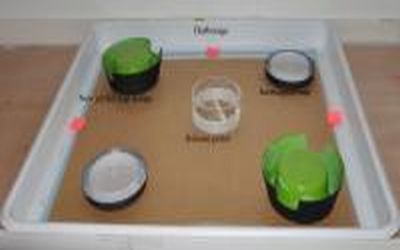New Trap Captures Bed Bugs More Effectively
A new pitfall trap designed to capture bed bugs is more effective than those currently on the market, according to the authors of an article appearing in the next issue of the Journal of Economic Entomology. The authors also found that traps baited with an experimental chemical lure mixture caught 2.2 times as many bed bugs as traps without the lure. Their findings suggest that an effective and affordable bed bug monitor can be made incorporating the new pitfall trap design, a chemical lure, and a sugar-and-yeast mixture to produce carbon dioxide, which is also known to attract bed bugs.


This image shows the experimental set up for determining the efficacy of a new pitfall trap design in a laboratory test.
A new pitfall trap designed to capture bed bugs is more effective than those currently on the market, according to the authors of an article appearing in the next issue of the Journal of Economic Entomology. The authors also found that traps baited with an experimental chemical lure mixture caught 2.2 times as many bed bugs as traps without the lure. Their findings suggest that an effective and affordable bed bug monitor can be made incorporating the new pitfall trap design, a chemical lure, and a sugar-and-yeast mixture to produce carbon dioxide, which is also known to attract bed bugs.
The three authors from the Rutgers University Department of Entomology, Narinderpal Singh, Changlu Wang, and Richard Cooper, report their findings in "Effect of Trap Design, Chemical Lure, Carbon Dioxide Release Rate, and Source of Carbon Dioxide on Efficacy of Bed Bug Monitors."
The new pitfall trap design was made with an inverted plastic dog bowl and the outer wall of the trap was covered with a layer of paper surgical tape which was dyed black. The lure mixture consisted of nonanal, 1-octen-3-ol, spearmint oil, and coriander Egyptian oil. Various sources and levels of carbon dioxde were also tested as attractants.
The new pitfall trap design caught significantly more (2.8-fold) bed bugs than the Climbup insect interceptor trap, which the authors name as the most effective monitor currently available on the market. Traps with the experimental lure caught 2.2 times as many bedbugs as unbaited traps. Traps baited with carbon dioxide also caught higher numbers of bed bugs, and higher rates of released CO2 were more effective than low rates. However, there were no significant differences between traps baited with CO2 derived from cylinders and CO2 derived from sugar and yeast, which is cheaper to produce.
The authors conclude that the new pitfall trap design is more effective because it is much taller than the interceptor trap, which makes it more difficult for bed bugs to escape, and that the effectiveness can be further enhanced by adding attractants such as carbon dioxide, chemical lures, or heat.
Source: Entomological Society of America (ESA)
Top 7 Infection Control Today Articles of 2024: Insights and Innovations
December 30th 2024From advanced sterilization methods to combating antimicrobial resistance, Infection Control Today’s top articles of 2024 delivered actionable strategies for safer healthcare environments and improved patient outcomes.
Redefining Competency: A Comprehensive Framework for Infection Preventionists
December 19th 2024Explore APIC’s groundbreaking framework for defining and documenting infection preventionist competency. Christine Zirges, DNP, ACNS-BC, CIC, FAPIC, shares insights on advancing professional growth, improving patient safety, and navigating regulatory challenges.
Pula General Hospital Celebrates Clean Hospitals
December 16th 2024Learn how Pula General Hospital in Croatia championed infection prevention and environmental hygiene and celebrated Clean Hospitals Day to honor cleaning staff and promote advanced practices for exceptional patient care and safety.
Tackling Health Care-Associated Infections: SHEA’s Bold 10-Year Research Plan to Save Lives
December 12th 2024Discover SHEA's visionary 10-year plan to reduce HAIs by advancing infection prevention strategies, understanding transmission, and improving diagnostic practices for better patient outcomes.
Environmental Hygiene: Air Pressure and Ventilation: Negative vs Positive Pressure
December 10th 2024Learn more about how effective air pressure regulation in health care facilities is crucial for controlling airborne pathogens like tuberculosis and COVID-19, ensuring a safer environment for all patients and staff.
Revolutionizing Hospital Cleanliness: How Color Additives Transform Infection Prevention
December 9th 2024Discover how a groundbreaking color additive for disinfectant wipes improved hospital cleanliness by 69.2%, reduced microbial presence by nearly half, and enhanced cleaning efficiency—all without disrupting workflows.